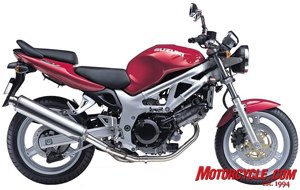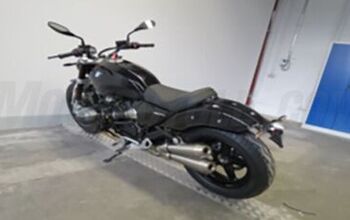2009 Suzuki Gladius Review - Motorcycle.com
Get the Flash Player to see this player.
Leaning against the chain-link fence to get as close a look as possible on the next go ‘round, I sheepishly asked a fellow race-watcher what bike was making that distinctly-Twin exhaust note. “That’s the new V-Twin from Suzuki,” said the motorcycle racing fan. My jaw fell open in mild astonishment. I’d only recently heard of the new bike, and was quite certain I hadn’t seen any in dealers yet, and here some die-hard enthusiast was already racing the thing. And so began American riders’ love affair with the Suzuki SV650.
The 645cc liquid-cooled, carbureted 90-degree V-Twin devoid of bodywork took almost no time to reach cult status with its sporty handling and user-friendly low-end and mid-range grunt. Its un-faired design caused the eye to immediately focus on the unique mill hanging from the aluminum, oval-tube trellis-style frame. Not many bike makers in those days embraced the naked streetfighter style for the American market.
Nevertheless, the SV’s ease-of-use made it a hit with Average Joe Rider for commuting and weekend play, while its overall performance caused a groundswell in club racing across the country, all for the 1999 MSRP of $5,699. The bike really was all that and a bag of chips.
The first major update to the SV – and the partially-faired SV650S model introduced in 2000 – arrived in ’03 and included fuel-injection, a new beefy square-tube truss frame and marginal increases in power and torque. In 2007 ABS became on option on either model, and in 2008 the S model went full-fairing as the SV650SF. For 2009 Suzuki perceived performance characteristics between the SV and SF models to be too close, so an all-new model emerged to adapt to changing market demands. We know everyone loved the good ol’ SV, but Suzuki has come up with a solution to fill the gap left by the standard SV’s departure: the 2009 Gladius.
The new Zook and its name draw inspiration from the Latin word for sword, in particular, a relatively short, more manageable version of longer swords. The obvious allusion is that Suzuki’s Gladius is a new and improved, sleeker, friendlier version of the SV. Equally obvious is the strong design element, one that went virtually unchanged from concept to showroom. With its rounded edges, flowing lines and friendly ergos, the Gladius is also an attempt by Suzuki to capitalize on the growing U.S. female rider segment.
To dispel any idea the Gladius is “a girl’s bike,” Suzuki’s Glenn Hansen points out that through a host of updates the new SV-derived V-Twin made gains in torque and power over the old SV. A safe guess is the Gladius increased torque at least 10% over the claimed 47-ish ft-lbs from the SV. Judging by a Suzuki-provided dyno graph superimposed over a graph from the previous SV, the gain appears across most of the rev range. Horsepower gains looked considerably less, though some increase was evident. It’s worth noting that none of the changes in the Gladius’ mill are found in the current SV650SF.
In a 2006 Motorcycle.com comparison an SV650S churned out 71.1 hp and 45.2 ft-lbs. These are already respectable figures, so any gain in the Gladius is great!
The SV engine rebornHere’s some of the updates that improve overall engine performance and allow the Gladius’ V-Twin to make more claimed torque across most of the rev range along with a small but notable increase in horsepower.
| Engine Updates: | |
| • Cylinders receive racing-derived SCEM (Suzuki Composite Eletrochemical Material) for better heat dissipation, reduced friction, etc. | |
| • 5% increase in crankshaft inertia enhances low-to-mid range output and “highlights power-pulse feel.” | |
| • Single spring per valve versus the SV650’s two springs per valve reduces inertia weight, and thereby mechanical losses. | |
| • High-lift cam for increased torque. | |
| • Throttle body intake funnels, though longer than what the SV650 used, are two different lengths for improved mid-range. | |
| • Idle Speed Control (ISC) system integrated into throttle body –first ever on any Suzuki street bike– improves idle, cold starting and eliminates additional wiring and hoses. The same 10-hole fuel injectors used on the GSX-R600 and 750 offer better atomization of fuel mixture. Two Iridium-tip spark plugs per cylinder complete the package for more thorough, consistent combustion which in turn is claimed to lead to better economy, emissions, power, etc. | |
| • All new compact exhaust with mid-chamber is claimed to increase low and mid-range torque while different length exhaust pipes allegedly improve low-end performance; exhaust design also contributes to lower CoG. | |
| • New radiator is smaller; oil cooler is now liquid-to-liquid rather than air-cooled, and its new design helps centralize mass. | |
A primary change in the chassis is the switch from the truss-type aluminum frame of the SV to a tubular steel trellis unit. As with the first generation SV, your eyes are quickly directed to the soft but prominent shapes of the frame that blend well with other design elements.
The pre-load adjustable 41mm Showa fork from the SV received a few small tweaks for general improvement, but the key change is a 5mm reduction in travel, useful in reducing seat height from 31.5 to 30.9 inches. Here again we can see a move aimed to attract shorter, perhaps female, riders. The link-type Showa shock retains its 5.1-inch travel and is adjustable for pre-load via the moderately accessible 7-position ramp adjuster.
Wheelbase is 56.9 inches versus 56.1 inches on the current SV650SF; rake remains 25.0 degrees while trail increased from 102 to 106mm.
Gladius maximus uses the same dual 290mm front rotors from the SV, though the two-piston sliding-pin front calipers’ pistons are a little over 3mm smaller in diameter and the master cylinder is marginally smaller. The rear brake pinches a 20mm larger rotor (240 v. 220mm). Wheels are now 5-spoke instead 3, but more importantly, the buns spooned onto the new rims are grippy Dunlop Qualifiers.
One possible downside for spec-sheet fanatics is the 8-lbs disadvantage the Gladius suffers in claimed ready-to-ride weight over the SV650SF’s 438 lbs curb weight. Weight-gain culprits are likely the steel versus aluminum frame and the new exhaust.
First impressions, lasting impressions
I’m willing to bet that even if this bike functions only half as well as an SV – though it certainly does and then some! – Suzuki will still have strong sales based solely on the European-inspired styling. Lead engineers spent considerable time in Europe whilst working on the Galdius, according to Hansen.
Sweeping lines and rounded edges are everywhere: From the 3.8 gal (3.6 in CA) fuel tank with removable two-piece trim that Suzuki says allows an overall narrower design, to the prominent organically shaped headlight, to the highly stylized exhaust, footpeg hangers and weapon-like passenger grab handles, the bike looks more sculpted than engineered.
Even the instrument cluster with centralized tach is easy on the eyes. The gear-position indicator is a good thing for this market, as are dual tripmeters, reserve fuel tripmeter and simple clock. Nicely done! Though wind protection is non-existent, windblast at freeway speeds is tolerable with little buffeting. But if you’d prefer, an accessory fly-screen is available.
The motorcycle’s inviting looks are not the least bit deceptive. Throwing a leg over is easy, as is flat-footing both footsies. Even if you have less than a 30-inch inseam you should feel secure thanks to the low, mostly flat saddle and the bike’s wasp-waisted center. Reach to the upright tubular handlebar is easy, though the distance between grips created a narrower feel than I prefer. Smaller riders will likely appreciate the compact layout.
The bike starts easily and settles into idle quickly courtesy of improvements in fueling as noted above. Light clutch lever action – an important trait for the intended audience – is thanks to a new cam-type release mechanism, and the 6-speed transmission is classic Suzuki: transparent.
Throttle response is good, albeit with a slight abruptness from closed-to-open transition, noticeable mostly in low rpm. Power is manageable and linear but certainly not flaccid. My seat-o-the-pants dyno says that the claimed power gains are there. The Gladius will easily wheelie in first gear with some help from the clutch, over-taking on the freeway doesn’t require downshifting from top-gear, and engine vibes are limited.
Twisty road fun is on the menu, and like the SV, the Gladius will harass faster bikes with its light and quick-steering chassis. However, there is a price point for this bike, and some things must be kept fiscally minded. The soft-ish suspension doesn’t allow perfect tractability through tight rapid-fire corners or over rough pavement if pushed like a supersport. More preload will help settle the chassis, but over compensating too much in this direction will only lead to a harsher ride the rest of the time you’re not dragging a peg. Also, padding in the stylish saddle is either too thin or too firm, or both. Part of the price paid for a low seat; however, a 20mm higher seat is available as an accessory.
Suzuki may have gone backward a bit with the mild downgrade in brake performance. Again, ample performance for 90% of the riders 90% of the time, but more initial bite and overall stopping power would go a long way on this motorcycle. I’ve said it before and I’ll say it again here: I’d prefer one, good 4-piston caliper and rotor rather than dual two-piston sliding pin jobs.
With an MSRP of $6,899 the Gladius is sandwiched perfectly between Kawasaki’s new nekkid. parallel-Twin based on the Ninja 650R, the ER-6n, at $6,399, and Yamaha’s budget-minded 600cc Four, the FZ6R, starting at $6,990.
Unless Kawasaki has graced the ER-6n with extra ponies beyond the Ninja 650R’s 65.6 hp as tested in our SV/Ninja 650R comparison, the Gladius may have a peak horsepower edge. Torque between the pair should be very close. The Yamaha’s reviver in-line Four may produce top-end figures similar or slightly higher than the Suzuki.
Razor’s edge performance gripes aside, the Gladius is a well-rounded package and very attractive. I expect many riders, regardless of experience, will take notice.
Related Reading
2006 Suzuki SV650S v. 2006 Kawasaki Ninja 650R
2006 Kawasaki Ninja 650R First Ride
Hyosung GT650 v. Suzuki SV650
2009 Suzuki Dealer Show Report
2009 Yamaha FZ6R Review
All things Suzuki on Motorcycle.com
More by Pete Brissette




































Comments
Join the conversation